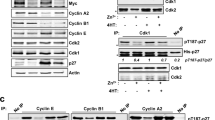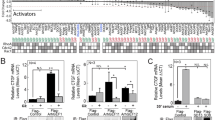Abstract
The response of a cell to mitogens and differentiation agents involves the transcriptional induction of several cellular genes. Prominent among these so-called 'immediate early' or 'competence' genes are the nuclear oncogenes fos and mycl–7. Although the precise function of these early response genes in growth control is not understood, it is likely that many of them are involved in the transition from G0 to G1 in the cell cycle. The findings that the products of nuclear proto-oncogenes jun and erbA are transcriptional factors supports the notion of the role of the nuclear oncoproteins in the regulation of gene expression8–11. Recently, it has been reported that the FOS protein is associated in transcriptional complexes with the product of the jun oncogene, the transcription factor AP-1 (refs 12–15). As the fos gene is induced in response to mitogens during initiation of cell growth, we investigated whether expression of the nuclear transcription factor AP-1 is also inducible. We report that mouse c-jun gene transcription is rapidly induced by serum and phorbol-ester 12-o-tetradecanoyl phorbol 13-acetate (TPA). Furthermore, induction is transient and the mRNA is superinduced by inhibitors of protein synthesis.
This is a preview of subscription content, access via your institution
Access options
Subscribe to this journal
Receive 51 print issues and online access
$199.00 per year
only $3.90 per issue
Buy this article
- Purchase on Springer Link
- Instant access to full article PDF
Prices may be subject to local taxes which are calculated during checkout
Similar content being viewed by others
References
Cochran, B. H., Reffel, A. C. & Stiles, C. D. Cell 33, 939–947 (1983).
Kelly, K., Cochran, B. H., Stiles, C. D. & Leder, P. Cell 35, 603–610 (1983).
Greenberg, M. E. & Ziff, E. B. Nature 311, 433–438 (1984).
Kruijer, W., Cooper, J. A., Hunter, T. & Verma, I. M. Nature 312, 711–716 (1984).
Muller, R., Bravo, R., Burckhardt, J. & Curran, T. Nature 312, 716–720 (1984).
Lau, L. F. & Nathans, D. Proc. natn. Acad. Sci. U.S.A. 84, 1182–1186 (1987).
Almendral, J. M. et al. Malec. cell. Biol. 8, 2140–2148 (1988).
Bohmann, D. et al. Science 238, 1386–1392 (1987).
Angel, P. et al. Nature 332, 166–171 (1988).
Sap, J. et al. Nature 324, 635–640 (1986).
Weinberger, C. et al. Nature 324, 641–646 (1986).
Rauscher, F. J. III, Sambucetti, L. C., Curran, T., Distel, R. J. & Spiegelman, B. M. Cell 52, 471–480 (1988).
Franza, R. B., Jr., Rauscher, F. J. III, Josephs, S. F. & Curran, T. Science 239, 1150–1153 (1988).
Rauscher, F. J. III et al. Science 240, 1010–1016 (1988).
Sassone-Corsi, P., Lamph, W. W., Kamps, M. & Verma, I. M. Cell 54 (in the press).
Lee, W., Mitchell, P. & Tjian, R. Cell 49, 741–752 (1987).
Angel, P. et al. Cell 49, 729–739 (1987).
Ryder, K., Lau, L. F. & Nathans, D. Proc. natn. Acad. Sci. U.S.A. 85, 1487–1491 (1988).
Vogt, P. K., Bos, T. J. & Doolittle, R. F. Proc. natn. Acad. Sci. U.S.A. 84, 3316–3319 (1987).
Shaw, G. & Kamen, R. Cell 46, 659–667 (1986).
Curran, T., Miller, A. D., Zokas, L. & Verma, I. M. Cell 36, 259–268 (1984).
Barber, J. R. & Verma, I. M. Molec. cell. Biol. 7, 2201–2211 (1987).
Kryszke, M.-H., Piette, J. & Yaniv, M. Nature 328, 254–256 (1987).
Devereux, J., Haeberli, P. & Smithies, O. Nucleic Acids Res. 12(1), 387–195 (1984).
Okayama, H. & Berg, P. Molec. cell. Biol. 3, 280–289 (1983).
Maniatis, T., Fritsch, E. F. & Sambrook, J. Molecular Cloning (Cold Spring Harbor Laboratory, 1982).
Henikoff, S. Gene 28, 351–359 (1984).
Sanger, F. et al. Nature 265, 687–695 (177).
Mitchell, R. L., Zokas, L., Schreiber, R. D. & Verma, I. M. Cell 40, 209–217 (1985).
Sassone-Corsi, P. & Verma, I. M. Nature 326, 507–510 (1987).
Gorman, C. M., Moffat, L. F. & Howard, B. H. Molec. cell. Biol. 2, 1044–1051 (1982).
Author information
Authors and Affiliations
Rights and permissions
About this article
Cite this article
Lamph, W., Wamsley, P., Sassone-Corsi, P. et al. Induction of proto-oncogene JUN/AP-1 by serum and TPA. Nature 334, 629–631 (1988). https://doi.org/10.1038/334629a0
Received:
Accepted:
Issue Date:
DOI: https://doi.org/10.1038/334629a0
This article is cited by
-
Skeletal muscle stem cells in comfort and stress
npj Regenerative Medicine (2018)
-
The E3 ubiquitin ligase Trim7 mediates c-Jun/AP-1 activation by Ras signalling
Nature Communications (2015)
-
Prognostic impact of transcription factor Fra-1 in ER-positive breast cancer: contribution to a metastatic phenotype through modulation of tumor cell adhesive properties
Journal of Cancer Research and Clinical Oncology (2015)
-
miR-1285-3p acts as a potential tumor suppressor miRNA via downregulating JUN expression in hepatocellular carcinoma
Tumor Biology (2015)
-
Protein kinase C-delta regulates HIV-1 replication at an early post-entry step in macrophages
Retrovirology (2012)
Comments
By submitting a comment you agree to abide by our Terms and Community Guidelines. If you find something abusive or that does not comply with our terms or guidelines please flag it as inappropriate.



